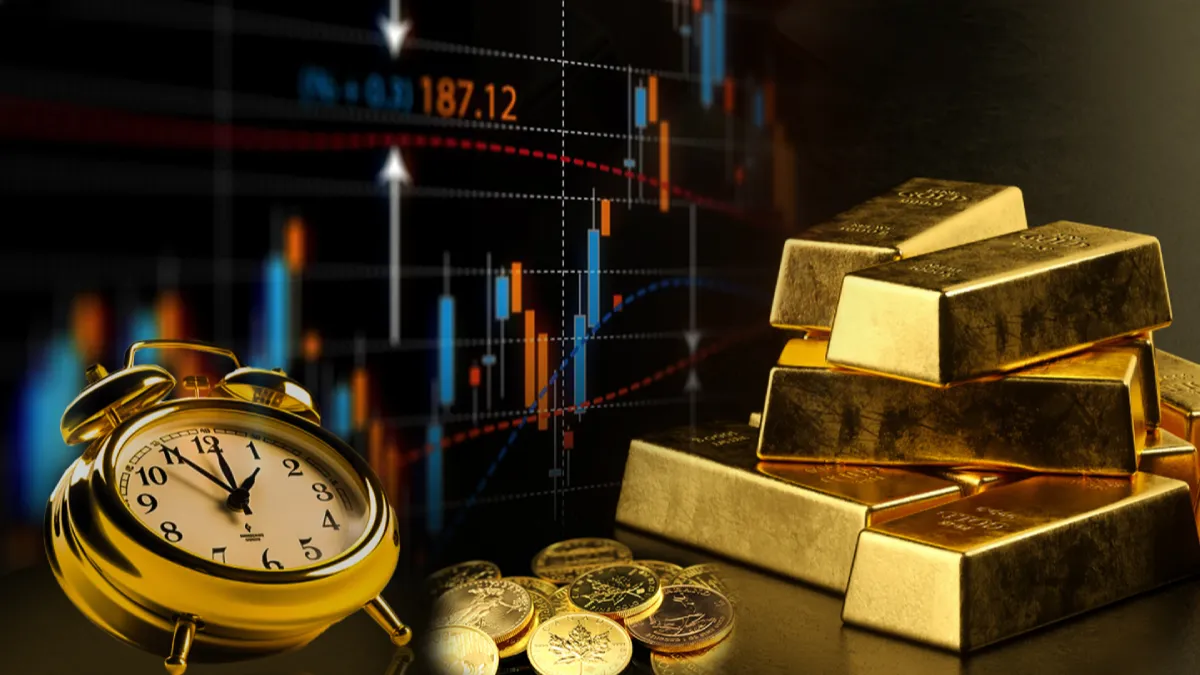Gold has held its status since the dawn of time as a symbol of wealth, power, and stability. From ancient empires to modern royalty, gold adorned palaces, funded conquests, and signified supreme authority. Revered for its rarity and beauty, it has long been trusted by rulers and dynasties to safeguard their wealth and secure their legacies. Today, gold still serves as a modern financial stronghold, providing a hedge against inflation, currency fluctuations, and economic instability. In recent years, investors have increasingly turned to gold not only for wealth preservation but also as a potential avenue for financial growth.
This article outlines progressive gold investment strategies, covering essential approaches to diversify holdings, earn income, and achieve financial growth while navigating market volatility.
Understanding the Financial Goals of Gold Investment
The first step to a successful gold investment strategy is clarifying your financial goals. Are you primarily seeking capital growth, steady income, or long-term wealth preservation? Gold can serve all three purposes, but the methods vary based on objectives.
For financial growth, it’s crucial to focus on strategies that balance stability with the potential for appreciation. Gold may not offer the same rapid growth as equities, but its stability and global appeal make it a unique asset that can provide significant returns over time, particularly in periods of economic downturns or inflation.
1. Diversify Your Gold Holdings
Diversification is essential to any robust investment strategy, and gold is no exception. Different forms of gold investment offer distinct advantages and risks, and a diversified approach can optimize both growth potential and stability.
Physical Gold
Tangible assets like gold bullion, coins, or jewelry are often regarded as the purest form of gold investment. Physical gold holds intrinsic value, unaffected by digital volatility, and can be especially valuable in times of high inflation or currency devaluation.
- Example: Suppose you buy a 1-ounce gold coin. This coin's value is not influenced by the stock market's ups and downs or digital market fluctuations. If inflation rises, the purchasing power of cash decreases, but the value of your gold coin likely increases, preserving your wealth.
Gold ETFs and Mutual Funds
If you prefer liquidity and easy management, gold exchange-traded funds (ETFs) and mutual funds are ideal. These funds track the price movements of gold without requiring you to hold the metal physically, providing a straightforward way to benefit from price increases.
- Example: Investing in a gold ETF like SPDR Gold Shares (GLD) allows you to buy and sell shares on the stock exchange, just like stocks. This provides the flexibility to quickly liquidate your investment if needed, unlike physical gold that requires finding a buyer and arranging for secure transfer.
Gold Mining Stocks
Investing in companies involved in gold mining can be a strong growth-oriented strategy. When gold prices rise, mining stocks can experience amplified growth, as the profitability of mining operations can exceed the increase in gold’s price. However, these stocks can be volatile, so they’re more suitable if you’re comfortable with higher risk.
- Example: Imagine you invest in a gold mining company like Barrick Gold Corporation. If gold prices soar, the company's revenue and profit margins could increase significantly, leading to a rise in its stock price. However, be aware that factors like mining operation challenges or regulatory changes can also impact stock performance.
Gold Futures and Options
Futures and options provide advanced ways to speculate on future gold prices, letting you lock in prices or gain leverage. These are complex tools best suited if you have experience with high-risk investments.
- Example: If you enter a futures contract to buy gold at today's price, and the price of gold rises by the contract's expiration date, you profit from the price difference. Similarly, with options, if you purchase a call option, you have the right to buy gold at a specific price before the option expires, potentially gaining if gold prices rise. However, these instruments can lead to substantial losses if prices move against your position.
By diversifying your gold investments across these different forms, you can optimize for both stability and growth. This approach helps mitigate risks associated with any single investment type, making your portfolio more resilient to market fluctuations.
2. Implement Dollar-Cost Averaging (DCA)
To minimize the impact of gold price fluctuations, consider using a dollar-cost averaging (DCA) strategy. By investing a fixed amount in gold at regular intervals, you smooth out the impact of market volatility, buying more when prices are low and less when they are high. This approach is particularly beneficial in markets with frequent fluctuations, as it reduces the risk of buying all at once at a peak price.
- Example: Imagine you decide to invest $500 in gold every month. In January, the price of gold is $1,800 per ounce, so you buy approximately 0.278 ounces. In February, if the price drops to $1,700 per ounce, your $500 buys about 0.294 ounces. Then in March, the price rises to $1,900 per ounce, and your $500 buys around 0.263 ounces. Over time, this approach means you accumulate gold at different price points, averaging out your cost and reducing the risk of making a large investment at an inopportune time.
By consistently investing the same amount regardless of the market's ups and downs, you can build a solid position in gold. This strategy can be particularly reassuring during periods of high volatility, as it allows you to take advantage of lower prices without the stress of trying to time the market perfectly.
3. Allocate Gold as a Hedge in a Diversified Portfolio
While gold has growth potential, it’s most effective as part of a balanced portfolio. A typical recommendation is to allocate between 10-15% of your portfolio to gold, depending on your risk tolerance and financial goals. This allocation allows you to benefit from gold’s stability during economic turbulence without limiting growth in other sectors like equities, which may offer higher returns in the long term. Gold’s ability to retain value during downturns makes it a strong hedge that helps to protect your portfolio’s overall value.
For example, if you have a $50,000 portfolio, allocate $5,000–$7,500 to physical gold or gold ETFs available through HKKO GOLD. Our team can assist in selecting the right products based on your investment goals.
Outcome:
This allocation ensures your portfolio remains resilient during economic downturns. For instance, in 2020, when the global economy faced uncertainty, gold prices increased by 25%, safeguarding investors from equity losses. With HKKO GOLD’s high-quality products, you gain a reliable hedge against market fluctuations.
4. Leverage Gold in Times of Inflation and Market Volatility
One of the key roles of gold is as a hedge during inflation and market volatility. In these times, gold prices tend to rise, as investors seek assets that hold value. A tactical approach is to increase your gold exposure when inflation indicators are high or when economic data suggests potential downturns. This can provide substantial protection and growth potential, even in challenging market conditions.
For instance, if inflation exceeds 3% annually, you could invest an additional $2,000 into gold through HKKO GOLD Their team also offers market insights, ensuring you time your purchases effectively for maximum growth potential.
Outcome:
Gold’s price typically rises during inflationary periods, protecting your portfolio’s value. For example, during the pandemic-induced uncertainty in 2020, gold surged to over $2,000 per ounce. By leveraging HKKO GOLD’s expertise, you can navigate inflationary cycles with confidence, securing growth even in challenging times
5. Earn Income Through Gold Investment Platforms
If you're looking to earn interest or income on gold, several platforms provide opportunities to achieve this:
Gold Savings Accounts:
Some banks offer gold savings accounts that pay interest on your gold balance. These accounts may hold the equivalent in physical gold or invest in gold-backed instruments, allowing you to earn returns passively.
HKKO GOLD provides gold savings accounts where your holdings generate interest over time. By depositing $10,000 worth of gold, you could earn passive income annually.
Gold-Backed Cryptocurrencies and Digital Gold:
Digital assets like Paxos Gold (PAXG) or Tether Gold (XAUT) represent ownership in gold and can sometimes be staked to earn interest. While these tokens provide liquidity and fractional investment options, they also expose investors to the volatility of digital assets, so they’re best suited for those with some comfort in digital markets.
Gold Lending Platforms:
Companies like Monetary Metals offer programs to lease gold to other entities in exchange for an annual interest yield. Their Gold Lease program allows investors to earn returns in physical gold, while their Gold Bonds pay fixed returns, creating an opportunity for steady income while retaining gold exposure.
HKKO GOLD’s Treasury Services allow you to lease your gold to corporate entities in exchange for interest, providing returns annually.
Gold Mining ETFs with Dividend Returns:
Although not interest-bearing, some gold mining ETFs distribute dividends, making them a potential source of passive income. These funds invest in dividend-paying gold mining companies, allowing you to benefit from both capital gains and dividend income.
6. Consider Innovative Gold Investment Options
Innovative options like digital gold and gold-backed cryptocurrencies have emerged, offering fractional ownership and ease of access without the storage requirements of physical gold. These assets are accessible through crypto exchanges and digital asset platforms, and some offer opportunities to earn interest through staking or lending. However, it’s essential to assess the risks associated with digital assets, including market volatility and security, before investing.
For investors seeking convenience and accessibility, HKKO GOLD offers innovative options like digital gold and fractional ownership. You can start small by purchasing digital gold worth $100 through their platform and build your holdings gradually. Alternatively, explore their gold-backed cryptocurrency options for fractional ownership without storage concerns.
Outcome:
Digital gold and gold-backed cryptocurrencies offer liquidity and ease of access, allowing you to adjust your holdings as market conditions change. For instance, investing $1,000 in digital gold through HKKO GOLD could allow you to benefit from gold price appreciation without logistical constraints.
7. Monitor Market Trends and Economic Indicators
Gold prices are influenced by various global factors, including currency rates, geopolitical events, central bank policies, and inflation indicators. Staying informed about these trends is crucial, as they help you determine optimal buying or selling opportunities. A strategy that includes both short-term tactics and long-term perspectives allows you to capitalize on both steady growth and timely market shifts.
Leverage HKKO GOLD’s market research and insights to stay updated on factors influencing gold prices, such as central bank policies, currency fluctuations, and geopolitical events. Their advisors provide regular updates and actionable recommendations tailored to your investment strategy.
For example, when HKKO GOLD. signals a potential price dip due to short-term economic stability, you can prepare to buy more gold. Conversely, when geopolitical tensions rise, increasing your holdings ensures your portfolio remains protected.
Outcome:
By staying informed, you can optimize your investment decisions. For instance, during the Brexit referendum, gold prices spiked as investors sought a safe haven. Using HKKO GOLD’s tools, you can act proactively to buy during dips and sell during price surges, maximizing your returns.
Conclusion
Gold investment is a versatile tool that can offer financial growth, income potential, and portfolio stability. By diversifying your holdings, leveraging gold during inflationary periods, and exploring platforms that offer income generation, you can create a resilient gold investment strategy. Gold may not provide the rapid growth of some other asset classes, but its enduring value, combined with the strategies above, can yield substantial long-term rewards and financial security.




